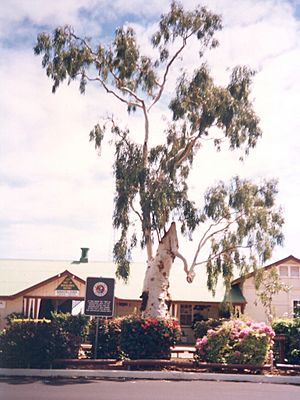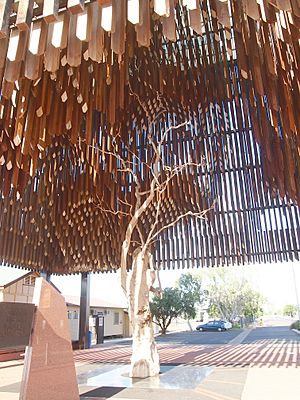Tree of Knowledge (Australia) facts for kids
Quick facts for kids Tree of Knowledge (Australia) |
|
|---|---|

The Tree of Knowledge, Barcaldine, 1997
|
|
| Location | Oak Street, Barcaldine, Barcaldine Region, Queensland, Australia |
| Design period | 1870s–1890s (late 19th century) |
| Built | 1891–1891 |
| Official name: Tree of Knowledge | |
| Type | state heritage (landscape) |
| Designated | 21 October 1992 |
| Reference no. | 600021 |
| Significant period | 1891 (historical) |
| Significant components | memorial – plaque, flagpole/flagstaff, memorial/monument |
| Lua error in Module:Location_map at line 420: attempt to index field 'wikibase' (a nil value). | |

The Tree of Knowledge was a famous old tree in Barcaldine, Australia. It was a special kind of gum tree called a ghost gum, and it was about 200 years old. Sadly, someone poisoned it in 2006, and it died. It was so important that it was added to a special list of historical places in Queensland in 1992.
This tree was a very important meeting spot for workers during a big strike in 1891. It's also where the ideas for the Australian Labor Party (a major political party) were first shared in 1892.
Contents
Why This Tree Was So Important
The Tree of Knowledge was a ghost gum tree located in front of the Barcaldine railway station. It became famous because workers involved in the 1891 Shearers' Strike met under its shade. This tree is a symbol for the Labor Party and workers' unions. It represents the start of organized groups for workers' rights in Queensland.
The Town of Barcaldine
Barcaldine became a town in 1886 when a railway line ended there. Before this, the area was mostly large sheep farms. These farms were like small towns themselves, with their own shops and places for workers to live. The farm owners had a lot of power over their workers, especially the sheep shearers who worked seasonally.
Workers often faced tough conditions and low pay. They also worried about losing their jobs to cheaper labor. This led to many workers feeling unhappy and wanting to make changes.
How Workers Started to Unite
Barcaldine was a natural place for workers to come together. As the end of the railway line, many seasonal workers, like shearers and railway builders, passed through or stayed there. It was hard to find work, and many faced money problems. This helped them feel a sense of friendship and support for each other.
In 1887, the Central Queensland Carriers Union was formed. People say that early discussions for this union happened under the very gum tree that offered shade at the railway station. Around the same time, the Queensland Shearers' Union was created. Within a year, it had 1,300 members. This showed that workers felt they needed to work together to get fair pay and better conditions. In 1888, the Central Queensland Labourers' Union was also formed in Barcaldine. These three unions were key to the big strike in 1891.
The Great Shearers' Strike of 1891
In Brisbane, a group called the Trades and Labour Council was formed in 1885. It later became the Australian Labour Federation. In Barcaldine, farm owners created their own group, the Pastoral Employers' Association, in 1889. They wanted to lower workers' pay. Many workers then joined the unions, with the Shearers' Union growing to over 3,000 members.
By January 1891, union leaders met in Barcaldine. Farm owners tried to make shearers sign contracts that didn't allow them to be part of a union. So, the unions called for a strike. Employers started bringing in workers who were not part of the unions. Strikers, some of whom had weapons, gathered in Barcaldine and set up camps around the town.
The Queensland Government sent police and soldiers to the area. The strikers responded by marching and holding torchlight parades in town. Since non-union workers, police, and soldiers usually arrived by train, the strikers would gather outside the railway station to protest. This made the Tree of Knowledge, right in front of the station, a central spot for meetings and protests.
In March 1891, the situation became more serious. Other workers, like carriers and railway workers, stopped working to support the shearers. More soldiers arrived. Barcaldine became the focus of the whole country, and people expected a fight. However, heavy rain made it hard to move around, and the arrest of union leaders slowed things down. Strikers began to leave. On June 15, the strike officially ended. It didn't achieve its goals right away, but it had a huge impact on Australia's future.
Birth of a Political Party
Even though the strike failed, it led to something very important. In 1892, under the Tree of Knowledge, a special document called the Manifesto of the Queensland Labour Party was read aloud. This document laid out the goals and beliefs of the new Labor Party in Queensland. It's seen as one of the founding documents of the Australian Labor Party we know today. The original manifesto is now kept at the State Library of Queensland.
In 2008, this manifesto was added to UNESCO's Memory of the World Australian Register. The next year, it was added to UNESCO's international list, recognizing its global importance.
A Symbol for Workers' Rights
The area under the Tree of Knowledge was where many important actions and decisions happened. These events deeply affected the future of workers' rights and politics in Australia. Because of this, the tree became a powerful symbol for the Labor Party and workers' unions. It's also very important to the people of Barcaldine as a symbol of their town's history.
In 1990, people found out the tree was sick with termites and other insects. Tree doctors and pest control experts worked hard to save it, giving it a new chance at life.
In 1991, Barcaldine held big celebrations for the 100-year anniversary of the Shearers' Strike. For this event, the area around the tree was improved, and a memorial for the strikers was built nearby.
The Tree's Sad End and New Beginning
In 2006, the tree was poisoned with a chemical called glyphosate. A tree expert confirmed the tree had died on October 3, 2006. The Labor Party offered a reward for information about who was responsible.
The remains of the tree were carefully removed on July 29, 2007. The wood was preserved, and the large trunk, about 7 meters tall and 2 meters wide, was moved to a special facility.
Before the original tree died, several small pieces were taken from it and grown into new trees. These "cuttings" are now growing in Barcaldine. In 2008, scientists successfully made copies, or "clones," of the tree. A clone of the tree has also been planted in Brisbane.
A new memorial was built where the original tree stood. It cost about A$5 million and was officially opened on May 2, 2009. This memorial won awards for its design and importance.
In 2009, as part of Queensland's 150th anniversary celebrations, the Tree of Knowledge was named one of the "Q150 Icons" of Queensland for its historical role.
On April 19, 2011, Australia's Prime Minister, Julia Gillard, helped plant a tree grown from an original cutting of the Tree of Knowledge at the National Arboretum Canberra.
What the Tree Looked Like
The Tree of Knowledge was a ghost gum tree (Corymbia aparrerinja) located outside the railway station on Barcaldine's main street. Old photos show it had a wider top than it did when it died. At the base of the tree, there was a plaque that said:
This plaque commemorates the loyalty, courage, and sacrifice in 1891 of the stalwart men and women of the west from whom, beneath this tree, emerged Australia's labour and political movement.
The Tree of Knowledge was protected by a modern metal fence. The area around it was decorated with flowering bushes and had a low fence made of logs. There was also a flagpole and a monument made of bronze and granite, shaped like shearer's blades. This monument was put up in 1991 to remember the 100th anniversary of the Shearers' Strike.
Why It's a Heritage Site
The Tree of Knowledge was added to the Queensland Heritage Register on October 21, 1992, because it met several important rules:
- It shows how Queensland's history changed.
The Tree of Knowledge was a key place during the Shearers' Strike in 1891. This strike was a major event in Queensland's history, showing the struggle between workers and employers. It was a turning point for the workers' rights movement and the start of the Australian Labor Party.
- It has a strong connection to a community.
The Tree of Knowledge is closely linked to the identity of Barcaldine and its people. It holds special meaning for them.
- It is connected to important groups in Queensland's history.
The Tree of Knowledge has a special connection to the history of the Australian Labor Party and the workers' union movement in Queensland.
See also
- List of individual trees
- List of named Eucalyptus trees

